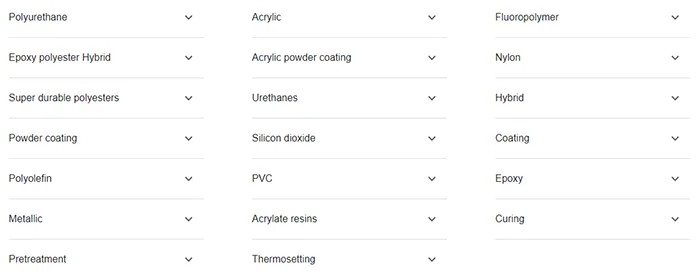Article Chapters
Powder coating is a versatile and popular finishing technique used across industries for its durability, eco-friendliness, and aesthetic appeal. Understanding the types of powder coatings available can help you choose the right one for your project. Let’s dive into the world of powder coatings and explore the various types and their unique characteristics, their thickness levels, and their resistance to high temperatures. Whether you’re new to powder coatings or looking to expand your knowledge, this guide has you covered.
What are the types of powder coatings?
When it comes to finishing options, your choice can significantly impact the performance and longevity of the coating, especially in specific environments. For the most durable finish, opt for options designed for specific application use.
Types of Powder Coatings: Thermoplastic and Thermosetting
Powder coatings are broadly categorized into two types based on their curing mechanism: Thermoplastic coatings (nylon, PVC, polyolefins, polyester fibers, fluoropolymers, polyurethane…), thermosetting coatings (epoxy resin, epoxy polyester, acrylic, silicone-based powder…).
Thermoplastic Coatings: Thermoplastic coatings are synthetic materials that soften when heated. They can be melted at high temperatures, allowing for reformation and recycling. While the reversibility and reusability of thermoplastic powder coatings have their advantages, they are not suitable for high-temperature environments.
Thermoplastic powder coatings are generally more durable than thermosetting coatings. They can be applied in thicker layers without becoming brittle. Manufacturers apply thermoplastic coatings to metal parts, automotive components, and kitchenware.
Thermosetting Materials: Thermosetting coatings can be turned into a liquid, eliminating all chemical bonds. In contrast, thermosetting materials undergo a chemical cross-linking reaction when heated, changing the plastic’s characteristics and forming a solid coating.
Thermosetting powder coatings cannot be recycled as the powder forms chemical bonds during curing. These bonds prevent the thermosetting material from melting, making it ideal for high-temperature environments. Despite their exceptional heat resistance, one drawback is that the thicker the application, the more brittle they become.

Whether you’re using a single-gun setup and a small oven or a large, fully automated production line, the process remains the same. In fact, there are thousands of different applications for powder coatings, each with its own characteristics and uses, so ensuring you have the right type of powder and color selection is crucial for successful application.
Here are the common powder coating types suitable for your project:
- Fluoropolymer coatings:
Fluoropolymers are fluorocarbon polymers with multiple carbon-fluorine bonds. It is characterized by high resistance to solvents, acids and alkalis. These coatings are known for their excellent weather and chemical resistance, making them ideal for architectural and automotive applications. All types of coatings in this category perform extremely well at resisting corrosion and chemical damage. Additionally, fluoropolymer coatings offer nonstick, low-friction properties while operating at temperatures up to 550 degrees Fahrenheit.
FEVE and PVDF are the two most commonly used fluoropolymers in powder coatings. PVDF fluoropolymers, whether liquid or powder, always require a primer underneath and are more difficult to bond when making metal powders. Nonstick properties, heat resistance and durability make fluoropolymer coatings the first choice for food molds, automotive parts, threaded fasteners, sliding surfaces, building components, vacuum molds and thermoforming molds. - Ceramic metal powder coating:
These coatings provide high performance in extreme temperatures and are suitable for industries such as aerospace, power generation, trucking, automotive and agriculture. In addition, the choice of cermets allows for flexibility or conductivity of the surface. This unique composite finish combines the properties of metal and ceramic to create its unique high-performance properties. - Nylon powder coating:
Nylon polymer coatings are known for their wear resistance, noise reduction, solvent resistance, oil resistance, workability, warm surface feel and dry lubrication properties. Due to the thickness of the surface coating, some processes may require applying nylon coating to the entire part and removing some coating from certain parts of the part. Nylon powder coated can withstand impact and abrasion. It provides excellent protection against chemicals and solvents and is FDA-approved for food contact. Metal parts that require wear resistance and lubricity while maintaining their machinability can use nylon as their coating. - PVC powder coating:
PVC coating is flexible, smooth and durable. They are also good electrical insulators for electrical wires and work well as a coating for chain link fences. And polyvinyl chloride (PVC) is approved by the FDA, and PVC coatings can be used in industries that require food contact. - Epoxy resin powder coating:
Epoxy resin is a widely used powder. These coatings are extremely tough, offering exceptional hardness and the best chemical and corrosion resistance of any powder coating. They are easy to use and offer a variety of curing options. Epoxy adheres to metal very effectively and good adhesion can be created through various metal pre-treatments such as phosphate coating and sandblasting.
The disadvantage of epoxy powders is that they tend to become brittle when exposed to UV rays for extended periods of time. If exposed to the elements, they may fade and chalk in the sun. They are less weather resistant. Therefore, epoxy resin is more suitable for indoor use. Finally, many primers are epoxy due to their bonding strength and corrosion resistance. Since they do not perform well in sunlight, using them as a pre-coat under another paint type can take advantage of their capabilities while masking their weaknesses. - Acrylic powder coating:
Acrylic paint has a high gloss and smooth appearance and performs better in the sun than epoxy paint. They can be blended onto the surface, leaving a high-gloss, wet, clear or colored finish. This topcoat offers excellent durability, chemical and weather resistance. However, this powder coating mixture has some limiting properties, specifically that it must be fairly thin because as the thickness increases, it starts to pull back on itself. - Polyester fiber powder coating:
Polyester is the most commonly used powder and offers excellent value. The two most common varieties of polyester powder are TGIC (triglycidyl isocyanurate) and non-TGIC, often referred to as TGIC-free or “Primid.” Polyester fiber powder coatings all have excellent mechanical properties, including high flexibility and impact resistance, as well as excellent chemical resistance. One of the advantages of this powder is that it cures at low temperatures. Ideal for sensitive cargo and construction industries due to low temperature requirements. Traditional polyester comes in a variety of colors, glosses, and special effects, which is a huge advantage. Standard polyester powder coating retains color and gloss for 1-3 years, and ultra-durable polyester retains color and gloss for 5-10 years. - Polyurethane powder coating:
Polyurethane powder coatings are chemically similar to polyester, but they use different curing agents. Polyurethane coatings provide a smooth surface, excellent exterior durability, chemical resistance, and resistance to moisture and corrosion, making them ideal for fuel products and other applications exposed to the elements. - Epoxy polyester hybrid powder coating:
Epoxy and polyester are often combined to create epoxy-polyester hybrid powder coatings. These mixtures are similar to pure epoxies but have better climate-degrading properties. These hybrid powder coatings can be combined in different proportions to enhance the properties of epoxy or polyester. Polyester improves overbake resistance and produces an ultra-smooth thin layer compared to pure epoxy, and reduces the corrosiveness and chemical resistance of epoxy without increasing the product’s external weather resistance. The combination of resins can also make it more cost-effective than pure epoxy resin. They also have excellent mechanical properties and very good chemical and corrosion properties.
Hybrid powder coatings are often used in areas where both good aesthetics and practical functionality are required. - Polyolefin powder coating:
Polyolefin coating is a thermoplastic that is resistant to abrasion and chemicals. and provides a smooth surface and excellent bonding properties. With its excellent adhesion, polyolefin powder coatings produce a final finish with a very smooth surface. Because of these advantages, polyolefin coatings are used on parts of laboratory equipment that require regular cleaning. - Silicone-based powder coating:
High temperature powder composed of silicone resin, curing catalyst and glass filler. They can withstand temperatures in excess of 1,000 degrees Fahrenheit, making them comparable to the best high-temperature ceramic coatings. They are used on car and motorcycle parts, as well as exhaust system finishes for ovens and grills.
Powder coatings offer a wide range of options to suit various application needs. Whether you need a durable finish for outdoor furniture or a heat-resistant coating for industrial equipment, there is a powder coating type to meet your requirements. Understanding the different types of powder coatings available can help you make an informed decision for your next project.
How thick is powder coating?
When it comes to powder coating, thickness plays a crucial role in ensuring the durability and effectiveness of the finish. The standard thickness range for powder coating is typically between 2 to 4 mils (50 to 100 microns). This thickness provides adequate coverage and protection for most applications.
The minimum thickness for powder coating is around 1.5 mils (38 microns). Anything thinner than this may not provide sufficient coverage or durability, leading to premature wear and corrosion.
On the other end of the spectrum, the maximum thickness for powder coating is generally around 10 mils (250 microns). Coatings thicker than this can lead to issues such as orange peel, poor adhesion, and uneven curing.
Achieving the right thickness for your powder coating requires careful application and monitoring. Proper equipment, such as a powder coating thickness gauge, can help ensure that you stay within the optimal thickness range for your specific application.
Why do you need to measure coating thickness?
Powder coating thickness can significantly impact the performance and durability of the coating. It may affect the coating’s resistance to impacts, flexibility, hardness, edge coverage, fracture resistance, weather resistance, salt spray resistance, and ability to retain gloss. Manufacturers provide production specifications for the powder coating material, and powder coating applicators strive to apply a uniform coating that meets these specifications. The measurement of powder coating thickness allows applicators to adjust their coating processes according to the specifications.
Furthermore, the design intent of the coating is best realized when applied within the strict thickness range specified by the manufacturer. This ensures optimal product performance. Many physical and visual properties of the finished coating are influenced by film thickness. Film thickness affects the coating’s color, gloss, surface contour, adhesion, flexibility, impact resistance, and hardness. When film thickness is outside the specified tolerance range, the fit of assembled parts may be affected. Therefore, coatings must be applied within certain minimum and maximum film thickness specifications to optimize their intended use.
In conclusion, the thickness of powder coating is an important factor that directly impacts its performance and longevity. By understanding the standard thickness range and ensuring proper application, you can achieve a high-quality finish that meets your needs.
What temp can powder coating withstand?
Powder coatings are known for their durability and resistance to a variety of environmental factors, including high temperatures. Traditional non-high-temperature powder coatings in the past have withstood temperatures up to about 250°F, with temperature peaks up to about 175-205°C (350°F – 400°F). And modern standard powder coatings can typically withstand temperatures up to 200-250 degrees Celsius (392-482 degrees Fahrenheit). However, there are specialty powder coatings designed specifically for extreme temperature conditions that can withstand temperatures of 550°C (1022.000℉) and above, and even some high-end ceramic powder coatings can withstand temperatures as high as 980°C (1800°F). It is worth noting that high-temperature powder coatings are troublesome to spray and have poor lifespan and overall durability. This causes powder coatings used in high temperature environments to require regular maintenance. According to the temperature resistance of powder coating, we usually divide it into the following four grades.
General Purpose Powder Coatings:
This type of powder coating is the most common and can withstand temperatures from ambient to 200°F, meeting the needs of most typical applications. But once temperatures exceed 200°F, noticeable color changes and other problems may occur.
Fluoropolymer Powder Coating:
A common way to upgrade regular powder coatings is to use fluoropolymers, which are a class of plastic resins based on fluorine/carbon bonds. This material is characterized by its multiple carbon-fluorine bonds and is most commonly found in frying pans coated with Teflon powder coating. These coatings are generally rated for temperatures between 300°F and 500°F.
Special High Temperature Powder Coatings
Special high temperature resistant powder coatings still have good corrosion resistance and beautiful appearance at higher temperatures (between 600-1022°F). These coatings are used to protect heater covers and other commercial products from high temperatures. Heat-resistant powder coatings used in automotive exhaust systems can even withstand temperatures exceeding 600 degrees Celsius (1112 degrees Fahrenheit).
Ultra-High Temperature Ceramic Powder Coating
As mentioned above, ceramic coating is the most high temperature resistant coating currently available, with a temperature rating of up to 1,800°F. Used when projects involve extreme high temperature environments, it can be used as a thermal insulation material to reduce the heat dissipated from the surface, making it ideal for automobiles, aircraft and industrial applications with high requirements for heat dissipation and friction resistance.
When choosing a powder coating for high-temperature applications, several factors should be considered:

- Temperature Range:Determine the maximum temperature the coated object will be exposed to, and choose a powder coating that can withstand that temperature.
- Substrate Material:Consider the material of the substrate being coated. Some materials can withstand higher temperatures than others, so the powder coating should be compatible with the substrate material.
- Application Method:Ensure that the powder coating is applied correctly and uniformly to achieve the desired temperature resistance. Proper curing is also crucial for achieving the full temperature resistance of the coating.
- Material Composition:Look for powder coatings formulated with heat-resistant pigments and resins, such as silicone, epoxy, or polyester, that can withstand high temperatures without degradation.
- Cost: Consider the cost of the powder coating, including the material itself, application equipment, and labor. Specialized high-temperature powder coatings may be more expensive than standard coatings, so ensure it fits within your project budget.
- Application Method:High-temperature powder coatings often require specific application methods to ensure proper adhesion and curing. Consider the equipment and expertise needed for application when choosing a powder coating. Learn the detailed powder coating application process.
- Durability: Evaluate the durability of the powder coating, including its resistance to abrasion, chemicals, and UV exposure. A durable coating will provide long-lasting protection in high-temperature environments.
- Color and Finish: High-temperature powder coatings are available in a variety of colors and finishes. Choose a coating that meets your aesthetic requirements while providing the necessary temperature resistance.
- Regulatory Compliance:Ensure that the selected powder coating complies with relevant regulations and standards for your industry, such as those set by the FDA for food contact or environmental regulations for emissions.
- Supplier Reputation:Work with a reputable powder coating supplier who can provide technical support and ensure the quality and performance of the coating for your specific application.
Powder coating offers excellent temperature resistance, with specialized formulations available for extreme temperature conditions. By considering the factors mentioned above, you can select the right powder coating for your high-temperature application, ensuring long-lasting durability and performance, ensuring both performance and cost-effectiveness.
In conclusion, powder coatings offer a versatile and durable solution for a wide range of applications. Their ability to resist rust, withstand high temperatures, and provide a waterproof barrier makes them an excellent choice for various projects. For those seeking reliable suppliers, we recommend utilizing our platform, coatingsdirectory.com, where you can easily find and connect with trusted suppliers using our filtering options.
Is powder coating expensive?
Compared to what powder coating can do for you, the price is well worth it. The specific price depends on the size of the construction object, the preparation required, special customization needs and your region (labor costs vary in different regions). For detailed price and cost knowledge of powder coatings, you can go to our corresponding blog to learn more.
Does powder coating prevent rust?
Yes, after curing, powder coating forms a protective barrier that can prevent various types of corrosion. In most cases, applying a powder coating to metal will provide strong rust resistance, preventing unsightly rust stains or red streaks on decks or building facades. However, if damaged, the coating may develop small cracks where moisture can enter and cause rust.
Is powder coating heat resistant?
Yes, powder coating is highly heat resistant. Standard powder coatings can withstand temperatures of up to 200-250 degrees Celsius (392-482 degrees Fahrenheit), and some specialty powder coatings can withstand even higher temperatures.
Is powder coat waterproof?
Yes, after the spray-melt-cure process, powder coating exhibits excellent waterproof properties. Polyester powder coatings (PPC) in particular, which are becoming increasingly popular as a wet paint alternative, are known for their waterproof qualities.

